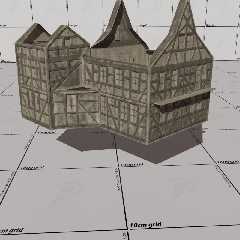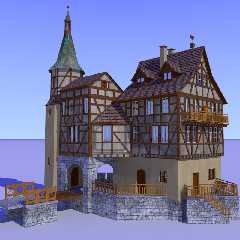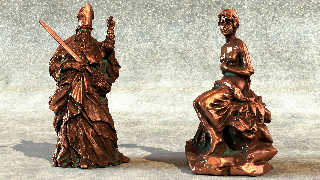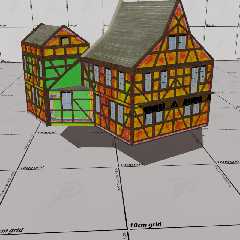 |
 |
|
 |
|
 |
|  |
|  |
|
 |
|
 |
|  |
|  |
|
 |
OK. I can as well show the state-of-the-art now while it is still in flux.
Proximity Patterns are notoriously difficult when used on flat surfaces.
They give the best results on complex surfaces with many creases. So,
knowing what I could expect, I started a series of tests and fine
tuning. I got an acceptable result using a separate object of the first
floor (see image EP_Proximity_Test.jpg). However, translating these
settings to the Gutenbach model - and assuming that I used exactly the
same settings - I got the second image (see image Gutenbach_test.jpg).
Not the same.
I think I know what happened and that means that I have to rethink part
of the model's geometry, at least where the texture use is concerned.
Bit for now, the experiment shows some promising possibilities.
--
Thomas
Post a reply to this message
Attachments:
Download 'ep_proximity_test.jpg' (114 KB)
Download 'gutenbach_test.jpg' (134 KB)
Preview of image 'ep_proximity_test.jpg'

Preview of image 'gutenbach_test.jpg'

|
 |
|  |
|  |
|
 |
|
 |
|  |
|  |
|
 |
Thomas de Groot wrote on 18/09/2017 13:32:
> OK. I can as well show the state-of-the-art now while it is still in flux.
>
> Proximity Patterns are notoriously difficult when used on flat surfaces.
> They give the best results on complex surfaces with many creases. So,
> knowing what I could expect, I started a series of tests and fine
> tuning. I got an acceptable result using a separate object of the first
> floor (see image EP_Proximity_Test.jpg). However, translating these
> settings to the Gutenbach model - and assuming that I used exactly the
> same settings - I got the second image (see image Gutenbach_test.jpg).
> Not the same.
>
> I think I know what happened and that means that I have to rethink part
> of the model's geometry, at least where the texture use is concerned.
> Bit for now, the experiment shows some promising possibilities.
>
Wow, it's a very nice effect: the first image seems a charcoal drawing
and the second...well, with a little work on the brown walls it could be
a fine art piece ;-)
Paolo
Post a reply to this message
|
 |
|  |
|  |
|
 |
|
 |
|  |
|  |
|
 |
Thomas de Groot <tho### [at] degroot org> wrote:
> OK. I can as well show the state-of-the-art now while it is still in flux.
>
> Proximity Patterns are notoriously difficult when used on flat surfaces.
> They give the best results on complex surfaces with many creases.
>
> I think I know what happened and that means that I have to rethink part
> of the model's geometry, at least where the texture use is concerned.
My having not done much like this I'm not sure what I'm looking at, but my
attempts to apply slope dependent texture on a large CSG building didn't go as
expected at all. Something about scale, I thought, or angular flat surfaces too.
Things like your building texture makes me wonder if surfaces normal can get
skipped over for others unintentionally. But its only the camera-facing wall,
which seems it is around 45 degrees to the others, that makes me wonder if it's
supposed to be that way.
Oh, BTW, is that lower window opening above the bridge a mistake? Trapezoid
shape there, unlike any others. I haven't checked messages about the previous
render to see if that was mentioned before.
Bob org> wrote:
> OK. I can as well show the state-of-the-art now while it is still in flux.
>
> Proximity Patterns are notoriously difficult when used on flat surfaces.
> They give the best results on complex surfaces with many creases.
>
> I think I know what happened and that means that I have to rethink part
> of the model's geometry, at least where the texture use is concerned.
My having not done much like this I'm not sure what I'm looking at, but my
attempts to apply slope dependent texture on a large CSG building didn't go as
expected at all. Something about scale, I thought, or angular flat surfaces too.
Things like your building texture makes me wonder if surfaces normal can get
skipped over for others unintentionally. But its only the camera-facing wall,
which seems it is around 45 degrees to the others, that makes me wonder if it's
supposed to be that way.
Oh, BTW, is that lower window opening above the bridge a mistake? Trapezoid
shape there, unlike any others. I haven't checked messages about the previous
render to see if that was mentioned before.
Bob
Post a reply to this message
|
 |
|  |
|  |
|
 |
|
 |
|  |
|  |
|
 |
Thomas de Groot <tho### [at] degroot org> wrote:
> OK. I can as well show the state-of-the-art now while it is still in flux.
>
> Proximity Patterns are notoriously difficult when used on flat surfaces.
> They give the best results on complex surfaces with many creases. So,
> knowing what I could expect, I started a series of tests and fine
> tuning. I got an acceptable result using a separate object of the first
> floor (see image EP_Proximity_Test.jpg). However, translating these
> settings to the Gutenbach model - and assuming that I used exactly the
> same settings - I got the second image (see image Gutenbach_test.jpg).
> Not the same.
>
> I think I know what happened and that means that I have to rethink part
> of the model's geometry, at least where the texture use is concerned.
> Bit for now, the experiment shows some promising possibilities.
>
> --
> Thomas
Hi Thomas,
probably you overcame the texture fit problem.
If not I can recommend proximity pattern by using an ambient occlusion render
together with the usage of Rune's illusion code. This method is fast and very
precise for small details.
Here is an example when testing some metal materials (no copper corrosion, but
perhaps partly cleaned small copper figures?).
Norbert org> wrote:
> OK. I can as well show the state-of-the-art now while it is still in flux.
>
> Proximity Patterns are notoriously difficult when used on flat surfaces.
> They give the best results on complex surfaces with many creases. So,
> knowing what I could expect, I started a series of tests and fine
> tuning. I got an acceptable result using a separate object of the first
> floor (see image EP_Proximity_Test.jpg). However, translating these
> settings to the Gutenbach model - and assuming that I used exactly the
> same settings - I got the second image (see image Gutenbach_test.jpg).
> Not the same.
>
> I think I know what happened and that means that I have to rethink part
> of the model's geometry, at least where the texture use is concerned.
> Bit for now, the experiment shows some promising possibilities.
>
> --
> Thomas
Hi Thomas,
probably you overcame the texture fit problem.
If not I can recommend proximity pattern by using an ambient occlusion render
together with the usage of Rune's illusion code. This method is fast and very
precise for small details.
Here is an example when testing some metal materials (no copper corrosion, but
perhaps partly cleaned small copper figures?).
Norbert
Post a reply to this message
Attachments:
Download 'copper proximity.jpg' (738 KB)
Preview of image 'copper proximity.jpg'

|
 |
|  |
|  |
|
 |
|
 |
|  |
|  |
|
 |
On 20-9-2017 1:08, Norbert Kern wrote:
> Hi Thomas,
>
> probably you overcame the texture fit problem.
> If not I can recommend proximity pattern by using an ambient occlusion render
> together with the usage of Rune's illusion code. This method is fast and very
> precise for small details.
>
> Here is an example when testing some metal materials (no copper corrosion, but
> perhaps partly cleaned small copper figures?).
>
Thanks indeed Norbert. I am working on it but I shall keep your
technique on the back burner for further investigation.
--
Thomas
Post a reply to this message
|
 |
|  |
|  |
|
 |
|
 |
|  |
|  |
|
 |
On 19-9-2017 22:27, omniverse wrote:
> My having not done much like this I'm not sure what I'm looking at, but my
> attempts to apply slope dependent texture on a large CSG building didn't go as
> expected at all. Something about scale, I thought, or angular flat surfaces too.
>
> Things like your building texture makes me wonder if surfaces normal can get
> skipped over for others unintentionally. But its only the camera-facing wall,
> which seems it is around 45 degrees to the others, that makes me wonder if it's
> supposed to be that way.
I am still working on it but my assumption is that the df3 pattern was
not used correctly and spread over a larger building portion than
intended, due to the use of identical initial textures. May sound
completely incomprehensible, I know, but at least /I think/ I know what
I am saying ;-)
>
> Oh, BTW, is that lower window opening above the bridge a mistake? Trapezoid
> shape there, unlike any others. I haven't checked messages about the previous
> render to see if that was mentioned before.
>
Yes, that is perfectly all right :-) There are a few more at the back.
Those are windows in a winding staircase.
--
Thomas
Post a reply to this message
|
 |
|  |
|  |
|
 |
|
 |
|  |
|  |
|
 |
Hmmm... I am getting frustrated now. I fine tuned the geometry and the
textures and still get the same problem, concentrated as it were, in the
green field in this false colours proximity image. I don't know what is
happening. :-/
--
Thomas
Post a reply to this message
Attachments:
Download 'ep_proximity_test1.jpg' (135 KB)
Preview of image 'ep_proximity_test1.jpg'

|
 |
|  |
|  |
|
 |
|
 |
|  |
|  |
|
 |
Am 20.09.2017 um 13:35 schrieb Thomas de Groot:
> Hmmm... I am getting frustrated now. I fine tuned the geometry and the
> textures and still get the same problem, concentrated as it were, in the
> green field in this false colours proximity image. I don't know what is
> happening. :-/
If the building isn't a single solid chunk, the walls might be too thin
for the proximity algorithm to work properly.
Post a reply to this message
|
 |
|  |
|  |
|
 |
|
 |
|  |
|  |
|
 |
On 20-9-2017 14:16, clipka wrote:
> Am 20.09.2017 um 13:35 schrieb Thomas de Groot:
>> Hmmm... I am getting frustrated now. I fine tuned the geometry and the
>> textures and still get the same problem, concentrated as it were, in the
>> green field in this false colours proximity image. I don't know what is
>> happening. :-/
>
> If the building isn't a single solid chunk, the walls might be too thin
> for the proximity algorithm to work properly.
>
That is true, which is why I closed all the openings. I am presently
testing a hunch which might be the solution...
--
Thomas
Post a reply to this message
|
 |
|  |
|  |
|
 |
|
 |
|  |
|  |
|
 |
[reading]
"Elementary, my dear Watson", said Sherlock Holmes, picking up the violin.
"Come on, Holmes, you do not pretend to have solved the disappearance of
Lord Gutenbach, do you? Even for you this case might be too difficult!"
The detective smiled while tuning the violin. "But I do have solved the
case, my friend. I often told you that when you had ruled out all the
obvious reasons, the most unlikely ones would prove to hold the key to
the mystery."
"And what was the key in this case?", asked Watson with a sceptical air.
"Oh, it was obvious once I thought about it. The key, my dear Watson,
was the index finger of Lord Gutenbach's left glove".
"You have lost me now, Holmes. Please explain."
"The key was the fact that it was a /yellow/ glove."
From: The Gutenbach House Mystery; unpublished
[/reading]
==============================================================================
Somehow the solution was elementary and yet still puzzling for me. The
object had been rotated 180 degrees /before/ calculating the df3, and
normally this should not have made a difference... except if I had
failed to take this rotation into account, somewhere, at a later stage.
I am unable yet to see where I went wrong but taking the rotation out
solves the case as the image shows.
--
Thomas
Post a reply to this message
Attachments:
Download 'ep_proximity_test.jpg' (136 KB)
Preview of image 'ep_proximity_test.jpg'

|
 |
|  |
|  |
|
 |
|
 |
|  |




![]()